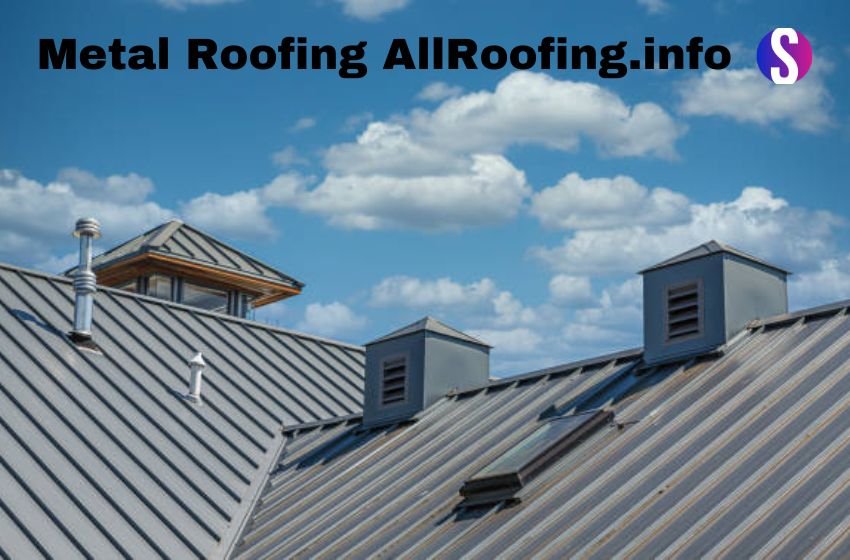Metal roofing has emerged as a top choice for residential and commercial buildings alike. Known for its durability, energy efficiency, and environmental benefits, metal roofing offers a wide array of advantages that traditional roofing materials cannot match. This article delves into the details of metal roofing, discussing its benefits, common types, and important installation considerations, all under the umbrella of Metal Roofing AllRoofing.info. Our blog site, Scroll Blogs, aims to provide in-depth insights and practical advice for anyone considering metal roofing for their home or business.
Benefits of Metal Roofing AllRoofing.info
Durability and Longevity
One of the most significant benefits of metal roofing, as highlighted by Metal Roofing AllRoofing.info, is its exceptional durability and longevity. Metal roofs can last anywhere from 40 to 70 years, depending on the material used. This is a stark contrast to traditional asphalt shingles, which typically need to be replaced every 20 years. The resistance of metal roofs to rot, mildew, and insect damage further enhances their lifespan, making them a cost-effective solution in the long run.
Energy Efficiency
Metal roofing is highly energy-efficient. It reflects solar radiant heat, which can reduce cooling costs by 10-25%. This is particularly beneficial in warmer climates where air conditioning costs can be a significant expense. By reducing energy consumption, metal roofs help homeowners save on utility bills and reduce their carbon footprint, aligning with the sustainability goals promoted by Scroll Blogs.
Environmental Impact
Metal roofing materials are often made from recycled content and are fully recyclable at the end of their life. This makes metal roofing an environmentally friendly option. The sustainability aspect is a crucial consideration for modern homeowners looking to reduce their environmental impact, and Metal Roofing AllRoofing.info emphasizes this benefit in detail.
Weight and Structural Benefits
Compared to other roofing materials like tile or slate, metal roofing is significantly lighter. This means that metal roofs can often be installed over existing roofs without the need for additional structural support. This not only saves on installation costs but also reduces the amount of waste generated during roof replacement projects, a point frequently discussed on Scroll Blogs.
Common Types of Metal Roofing Materials
Galvanized Steel
Galvanized steel is one of the most popular metal roofing materials due to its affordability and durability. It comes in a variety of styles and color options, making it a versatile choice for homeowners. However, it is more susceptible to corrosion compared to other metals like copper or zinc.
Copper
Copper roofing is renowned for its durability and aesthetic appeal. Copper roofs develop a distinctive patina over time, which many homeowners find attractive. Although copper is more expensive and less readily available than other metals, its long lifespan and resistance to corrosion make it a worthwhile investment.
Aluminum
Aluminum is a lightweight and corrosion-resistant option, particularly suitable for coastal areas. It is highly malleable, making it ideal for complex roof shapes. However, aluminum roofs can be more prone to denting compared to steel.
Zinc
Zinc is another durable and aesthetically pleasing metal roofing material. It shares many of the same benefits as copper, including resistance to corrosion and a long lifespan. Zinc roofs are less common and more expensive, but they offer a unique blue-grey patina that evolves over time.
Installation Considerations for Metal Roofing AllRoofing.info
Precision in Measurements
Accurate measurements are crucial when installing metal roofs. Incorrect measurements can lead to panels that are too short or too long, which can compromise the roof’s integrity and aesthetics. This highlights the importance of detailed planning and precision in the installation process, a point emphasized by Metal Roofing AllRoofing.info.
Proper Fastening
Ensuring that screws are properly fastened is essential to prevent leaks and ensure the longevity of the roof. Over-tightening or under-tightening screws can lead to issues with the roof’s performance. Proper training and experience are crucial for installers to achieve the best results.
Handling Expansion and Contraction
Metal panels can expand and contract with temperature changes. It’s important to account for this movement during installation to prevent issues with panel alignment and fit. Experienced installers understand how to accommodate these changes, ensuring a durable and long-lasting roof.
Choosing the Right Material
Different metals have different properties, and the choice of material should be based on factors like climate, budget, and aesthetic preferences. Metal Roofing AllRoofing.info provides detailed comparisons of various metal roofing materials, helping homeowners make informed decisions.
The Role of Scroll Blogs in Promoting Metal Roofing AllRoofing.info
At Scroll Blogs, we aim to educate and inform our readers about the latest trends and best practices in home improvement, including metal roofing. By providing comprehensive guides and detailed articles, we strive to help homeowners make informed decisions about their roofing options. Our focus on Metal Roofing AllRoofing.info reflects our commitment to promoting durable, energy-efficient, and environmentally friendly roofing solutions.
Conclusion
Metal Roofing AllRoofing.info provides invaluable insights into the benefits, types, and installation considerations of metal roofing. With its emphasis on durability, energy efficiency, and environmental impact, metal roofing is a superior choice for both residential and commercial applications. By choosing the right materials and following best practices for installation, homeowners can enjoy the long-lasting benefits of a metal roof. For more detailed information and practical advice, visit Scroll Blogs, your trusted source for home improvement insights.

